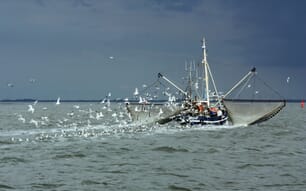This was the message delivered at the Bord Iascaigh Mhara (BIM)-hosted conference titled Farmed Irish Seaweed: An Ocean Wonder Food? on 18 November at The Radisson Hotel, Limerick, as the Agency's first report on Irish seaweed farming was unveiled.
Findings from “The European Market for Sea Vegetables”, a study specially commissioned by BIM for the conference, show Ireland targeting 2,000 metric tonnes (harvest weight) per year of seaweed farmed for human consumption as it competes to develop a niche in the six billion-dollar worldwide farmed seaweed industry currently dominated by China and Japan, the global heavyweights in the eight million tonne farmed sea vegetable and 25 million tonne seaweed industry.
The demand for European farmed seaweed increasing by approximately 7-10 per cent per annum, could lead to 100 new jobs being created on seaweed farms predominantly along Ireland's west/ south-west coastline while downstream processing of the new seaweed crops would also lead to a further 80 to 100 jobs in the region.
Commenting in advance of the report's publication, conference keynote speaker Amarjit Sahota said: “The European market for sea vegetables estimated at about €24 million at a wholesale value is considered to have high prospects for Irish producers for two primary reasons. First, Ireland is already established as an important seaweed producer; it is therefore well equipped to raise production levels of sea vegetables. Second, the European market is suffering from undersupply with production falling short of demand. Imports comprised about 75 per cent of total sales volumes in 2013.”
Mr Sahota urged Irish seaweed farmers targeting the European market to look at other seaweed processors as partners rather than competitors. “This is because undersupply leads major processors to import from other European countries and/or outside Europe. Many processors would welcome a new source of sea vegetables, as it would enable them to increase supply and raise sales.”
The report goes on to advise that while Ireland should continue to farm 'the brown seaweed species (Alaria esculenta and Laminaria saccharina), of the type already being grown at sites in West Cork's Roaring Water Bay and at Dingle Bay, it should also target higher value red seaweed, which is used as nori in sushi (Porphyra umbilicalis).
Global consumption of sea vegetables is rising as consumers become more aware of their health and nutritional benefits. Sea vegetables are an important source of protein and vitamins, specifically vitamins A, C, E, B1, B2, B6, and B12. Seaweeds are also known to have strong beneficial properties for gut health, are anti-carcinogenic and promote better hormone balance in women. New research indicates that seaweed may have a powerful role to play in controlling fat deposition and weight management.
Commenting for BIM, Donal Maguire, the Agency's Director of Aquaculture Development Services said: “About 472 tonnes of sea vegetables were sold in 2013 in the EU. It would have taken almost 5,000 tonnes of harvest weight seaweed to generate this finished product. About a quarter of the market is supplied by European producers, mainly based in France and Spain but in BIM we foresee Ireland being able to take on a growing role to help fill the undersupply problem by EU seaweed farmers.”
There are openings for Irish producers in all product segments. Although nori is the largest in terms of volumes, most prospects are considered with dulse. Dulse is the second largest product segment, with sales volume at 70 tonnes (initial harvest weight of 700 tonnes) in 2013. Ireland is already the second largest producer of dulse, exporting about five tonnes per annum (52 harvest weight). The segment is also the least dependent of imports, which comprise 10 per cent of sales.
Wakame and kombu are also prospective, however their markets are relatively smaller 64 tonnes, product weight (initial harvest weight 660 tonnes) and 50 tonnes, product weight (initial harvest weight 508 tonnes) respectively; imports comprise 60 per cent and 50 per cent of total sales volumes respectively. Ireland is also not a major producer of these sea vegetables.
The nori market is the largest, with 288 tonnes (initial harvest weight 2950 tonnes) sold in 2013.
BIM hosted the seaweed conference in response to “increasing levels of interest in both seed hatchery development and on-growing. This has come from existing mussel farmers who would like to expand into something which compliments their existing business, as well as entirely new ventures,” said Mr Maguire.
“We expect the conference to bring people from the national and international seaweed businesses together, to share technology and look at what the EU, our home market, can absorb.”
“Farmed seaweed seems to be a very good prospect, at price levels which make seaweed viable economically,” he said.
Sessions at the Limerick event will cover the European marketplace, nutrition, handling and processing, hatchery and grow-out techniques, and Irish funding support for projects.
Among the speakers are seaweed specialist and food writer Sally McKenna, Michael Murphy and Kate Burns, representing existing Irish seaweed farms Dingle Bay Seaweeds and Ocean Veg Ireland respectively, as well as Yoichi Sato, of Riken Food Co. in Japan.


